Analysis of Developing Leadership and Management Skills: A Report
VerifiedAdded on 2020/03/28
|22
|3935
|537
Report
AI Summary
This report provides a comprehensive analysis of leadership and management skills. It begins by differentiating between leadership and management, exploring various interpretations and highlighting the distinct roles and responsibilities of each. The report then delves into different approaches for developing leaders and managers, including management approaches like classical, human relations, social system, and contingency approaches, and leadership approaches such as trait and behavioral theories, including Hersey and Blanchard’s situational leadership theory. Furthermore, the report examines how the Learning and Development (L&D) function supports leadership and management development, preparing individuals for various positions and transitions within an organization. It also outlines indicators and methods for successful implementation of leadership and management development programs, providing a well-rounded overview of the subject. The report emphasizes the importance of communication, motivation, and emotional connections in effective leadership and management.
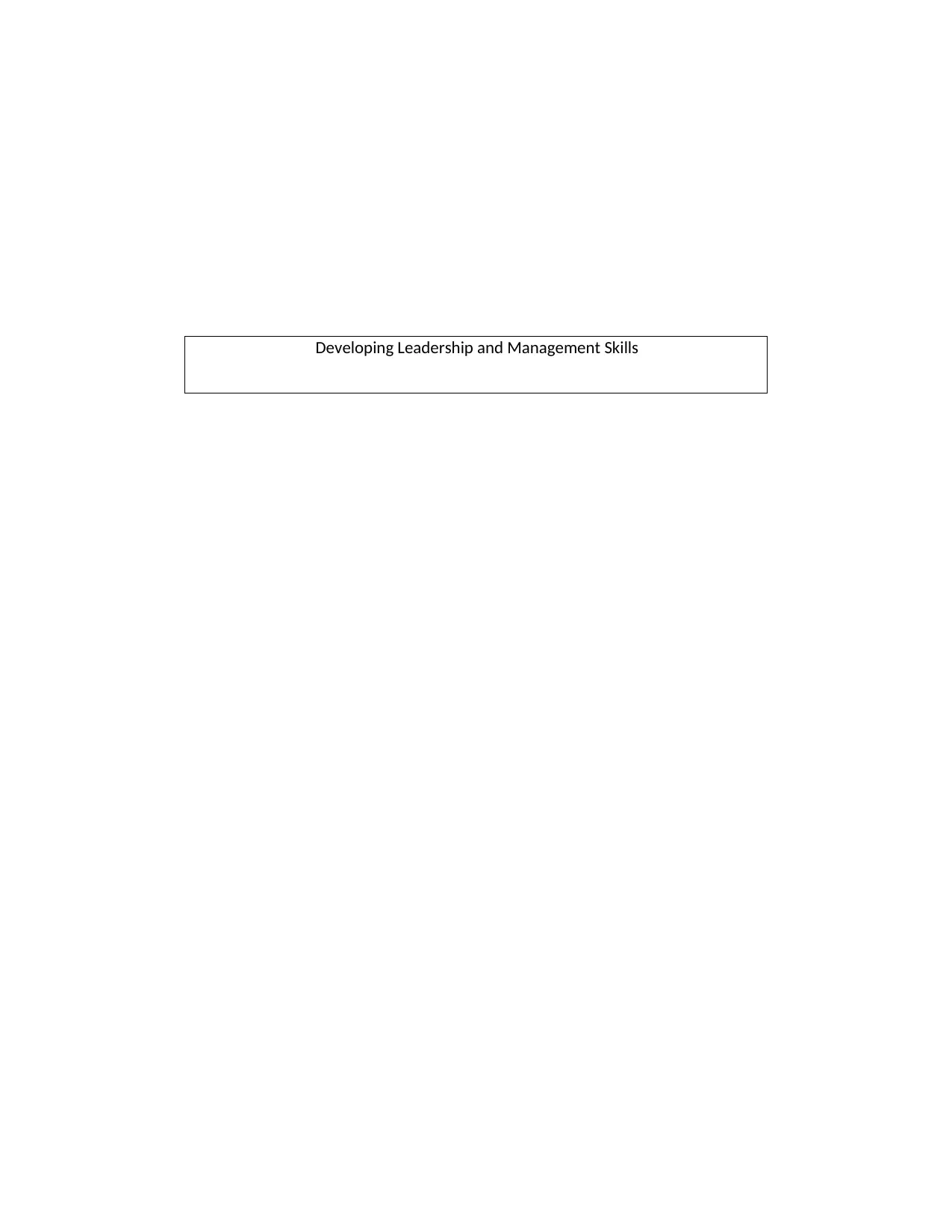
Developing Leadership and Management Skills
Paraphrase This Document
Need a fresh take? Get an instant paraphrase of this document with our AI Paraphraser
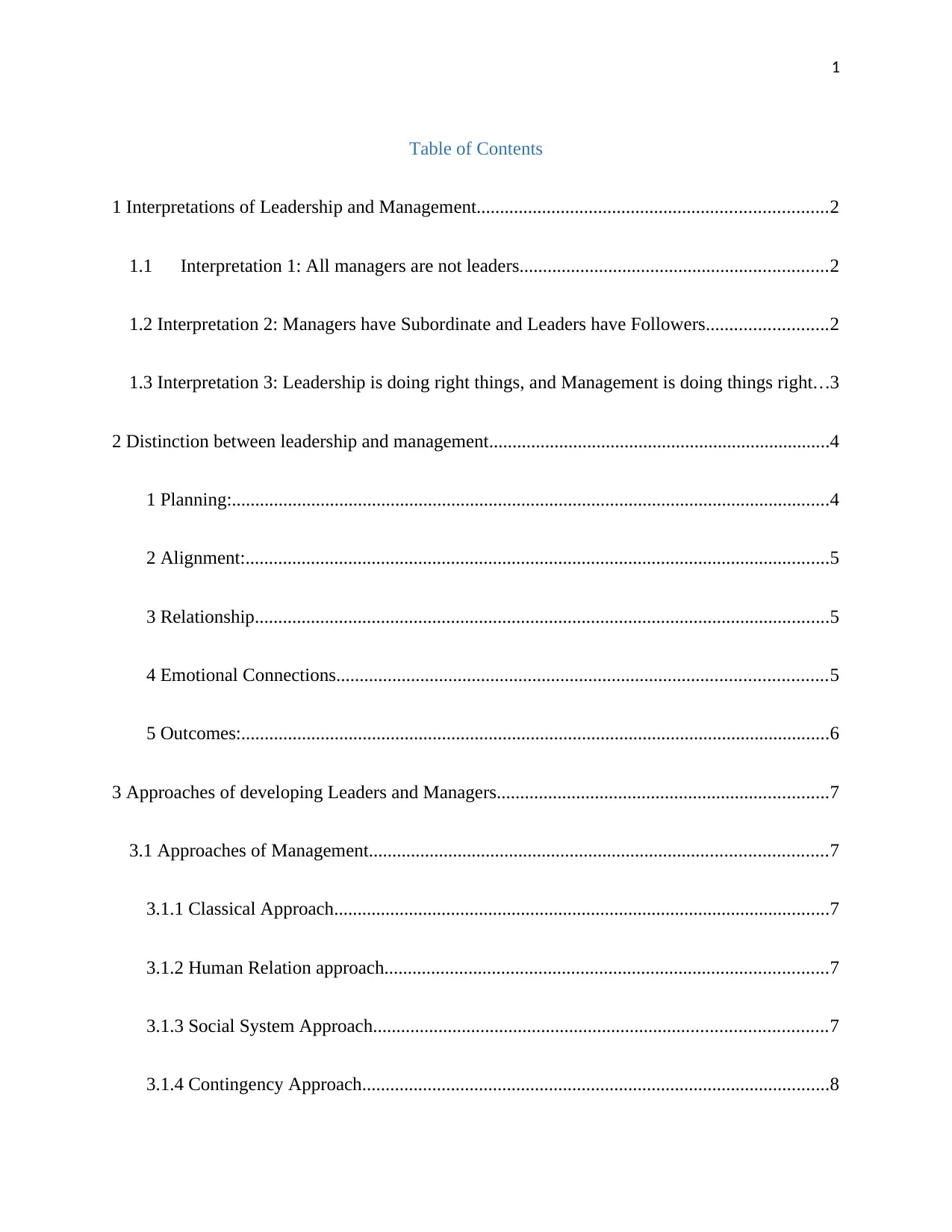
1
Table of Contents
1 Interpretations of Leadership and Management...........................................................................2
1.1 Interpretation 1: All managers are not leaders..................................................................2
1.2 Interpretation 2: Managers have Subordinate and Leaders have Followers..........................2
1.3 Interpretation 3: Leadership is doing right things, and Management is doing things right...3
2 Distinction between leadership and management.........................................................................4
1 Planning:................................................................................................................................4
2 Alignment:.............................................................................................................................5
3 Relationship...........................................................................................................................5
4 Emotional Connections.........................................................................................................5
5 Outcomes:..............................................................................................................................6
3 Approaches of developing Leaders and Managers.......................................................................7
3.1 Approaches of Management..................................................................................................7
3.1.1 Classical Approach..........................................................................................................7
3.1.2 Human Relation approach...............................................................................................7
3.1.3 Social System Approach.................................................................................................7
3.1.4 Contingency Approach....................................................................................................8
Table of Contents
1 Interpretations of Leadership and Management...........................................................................2
1.1 Interpretation 1: All managers are not leaders..................................................................2
1.2 Interpretation 2: Managers have Subordinate and Leaders have Followers..........................2
1.3 Interpretation 3: Leadership is doing right things, and Management is doing things right...3
2 Distinction between leadership and management.........................................................................4
1 Planning:................................................................................................................................4
2 Alignment:.............................................................................................................................5
3 Relationship...........................................................................................................................5
4 Emotional Connections.........................................................................................................5
5 Outcomes:..............................................................................................................................6
3 Approaches of developing Leaders and Managers.......................................................................7
3.1 Approaches of Management..................................................................................................7
3.1.1 Classical Approach..........................................................................................................7
3.1.2 Human Relation approach...............................................................................................7
3.1.3 Social System Approach.................................................................................................7
3.1.4 Contingency Approach....................................................................................................8
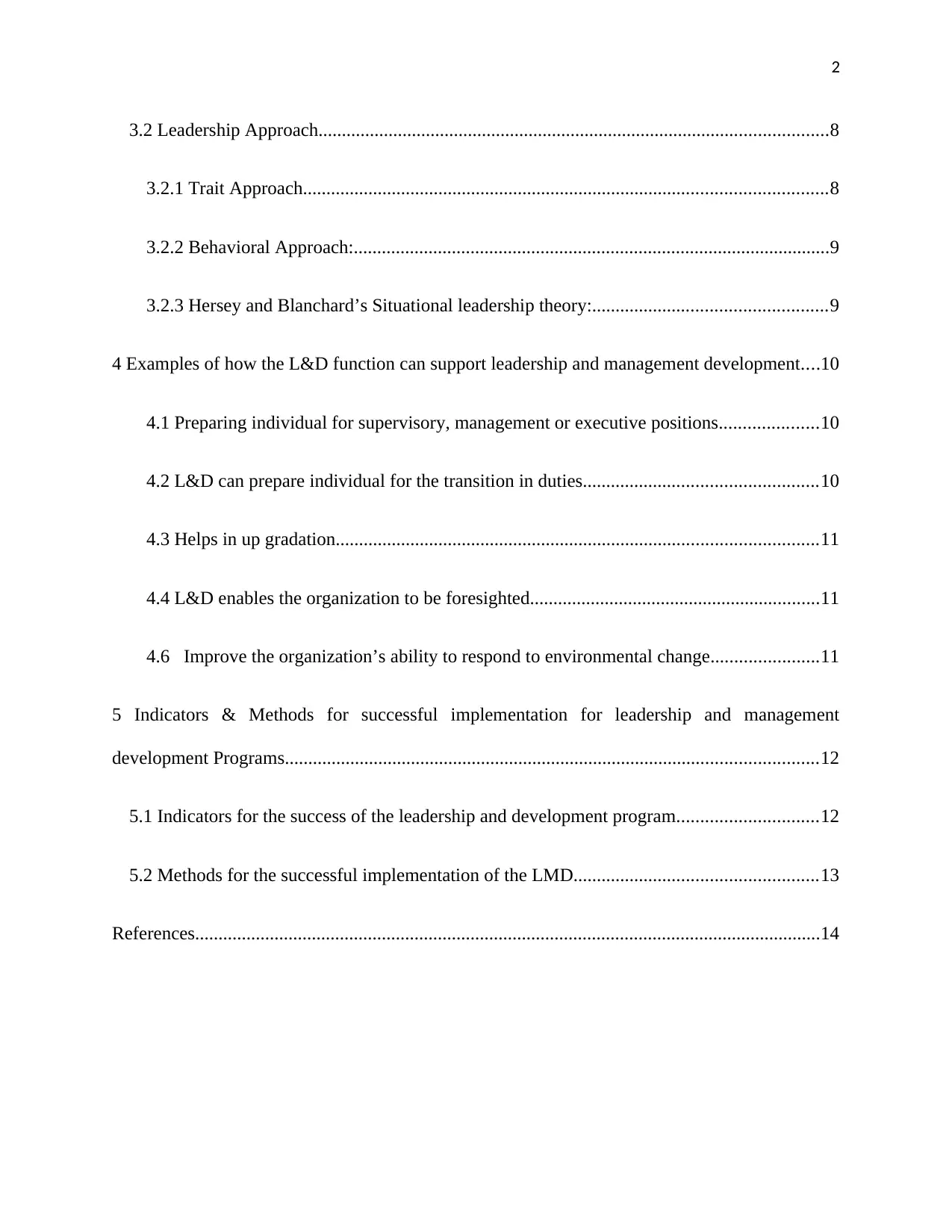
2
3.2 Leadership Approach.............................................................................................................8
3.2.1 Trait Approach................................................................................................................8
3.2.2 Behavioral Approach:......................................................................................................9
3.2.3 Hersey and Blanchard’s Situational leadership theory:..................................................9
4 Examples of how the L&D function can support leadership and management development....10
4.1 Preparing individual for supervisory, management or executive positions.....................10
4.2 L&D can prepare individual for the transition in duties..................................................10
4.3 Helps in up gradation.......................................................................................................11
4.4 L&D enables the organization to be foresighted..............................................................11
4.6 Improve the organization’s ability to respond to environmental change.......................11
5 Indicators & Methods for successful implementation for leadership and management
development Programs..................................................................................................................12
5.1 Indicators for the success of the leadership and development program..............................12
5.2 Methods for the successful implementation of the LMD....................................................13
References......................................................................................................................................14
3.2 Leadership Approach.............................................................................................................8
3.2.1 Trait Approach................................................................................................................8
3.2.2 Behavioral Approach:......................................................................................................9
3.2.3 Hersey and Blanchard’s Situational leadership theory:..................................................9
4 Examples of how the L&D function can support leadership and management development....10
4.1 Preparing individual for supervisory, management or executive positions.....................10
4.2 L&D can prepare individual for the transition in duties..................................................10
4.3 Helps in up gradation.......................................................................................................11
4.4 L&D enables the organization to be foresighted..............................................................11
4.6 Improve the organization’s ability to respond to environmental change.......................11
5 Indicators & Methods for successful implementation for leadership and management
development Programs..................................................................................................................12
5.1 Indicators for the success of the leadership and development program..............................12
5.2 Methods for the successful implementation of the LMD....................................................13
References......................................................................................................................................14
⊘ This is a preview!⊘
Do you want full access?
Subscribe today to unlock all pages.

Trusted by 1+ million students worldwide
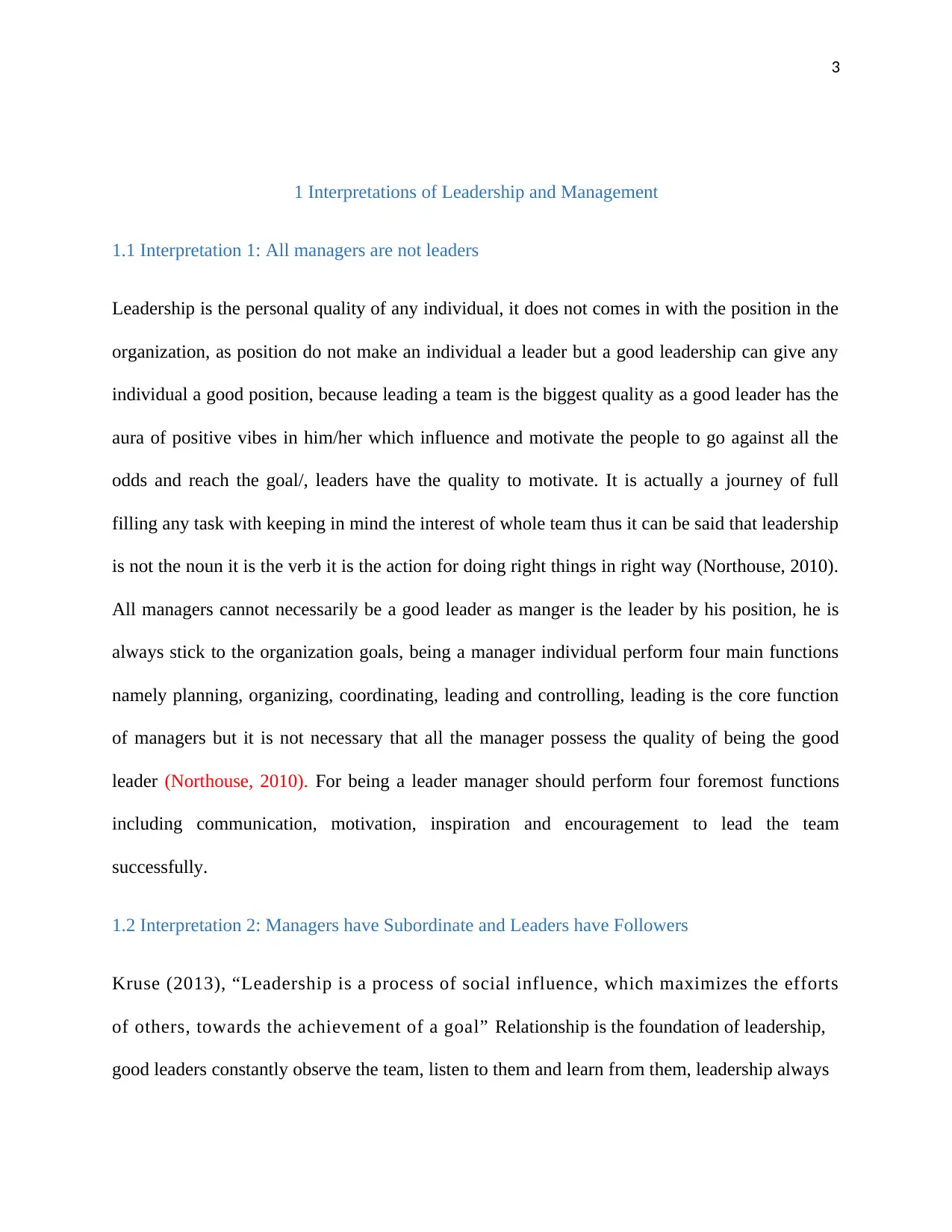
3
1 Interpretations of Leadership and Management
1.1 Interpretation 1: All managers are not leaders
Leadership is the personal quality of any individual, it does not comes in with the position in the
organization, as position do not make an individual a leader but a good leadership can give any
individual a good position, because leading a team is the biggest quality as a good leader has the
aura of positive vibes in him/her which influence and motivate the people to go against all the
odds and reach the goal/, leaders have the quality to motivate. It is actually a journey of full
filling any task with keeping in mind the interest of whole team thus it can be said that leadership
is not the noun it is the verb it is the action for doing right things in right way (Northouse, 2010).
All managers cannot necessarily be a good leader as manger is the leader by his position, he is
always stick to the organization goals, being a manager individual perform four main functions
namely planning, organizing, coordinating, leading and controlling, leading is the core function
of managers but it is not necessary that all the manager possess the quality of being the good
leader (Northouse, 2010). For being a leader manager should perform four foremost functions
including communication, motivation, inspiration and encouragement to lead the team
successfully.
1.2 Interpretation 2: Managers have Subordinate and Leaders have Followers
Kruse (2013), “Leadership is a process of social influence, which maximizes the efforts
of others, towards the achievement of a goal” Relationship is the foundation of leadership,
good leaders constantly observe the team, listen to them and learn from them, leadership always
1 Interpretations of Leadership and Management
1.1 Interpretation 1: All managers are not leaders
Leadership is the personal quality of any individual, it does not comes in with the position in the
organization, as position do not make an individual a leader but a good leadership can give any
individual a good position, because leading a team is the biggest quality as a good leader has the
aura of positive vibes in him/her which influence and motivate the people to go against all the
odds and reach the goal/, leaders have the quality to motivate. It is actually a journey of full
filling any task with keeping in mind the interest of whole team thus it can be said that leadership
is not the noun it is the verb it is the action for doing right things in right way (Northouse, 2010).
All managers cannot necessarily be a good leader as manger is the leader by his position, he is
always stick to the organization goals, being a manager individual perform four main functions
namely planning, organizing, coordinating, leading and controlling, leading is the core function
of managers but it is not necessary that all the manager possess the quality of being the good
leader (Northouse, 2010). For being a leader manager should perform four foremost functions
including communication, motivation, inspiration and encouragement to lead the team
successfully.
1.2 Interpretation 2: Managers have Subordinate and Leaders have Followers
Kruse (2013), “Leadership is a process of social influence, which maximizes the efforts
of others, towards the achievement of a goal” Relationship is the foundation of leadership,
good leaders constantly observe the team, listen to them and learn from them, leadership always
Paraphrase This Document
Need a fresh take? Get an instant paraphrase of this document with our AI Paraphraser
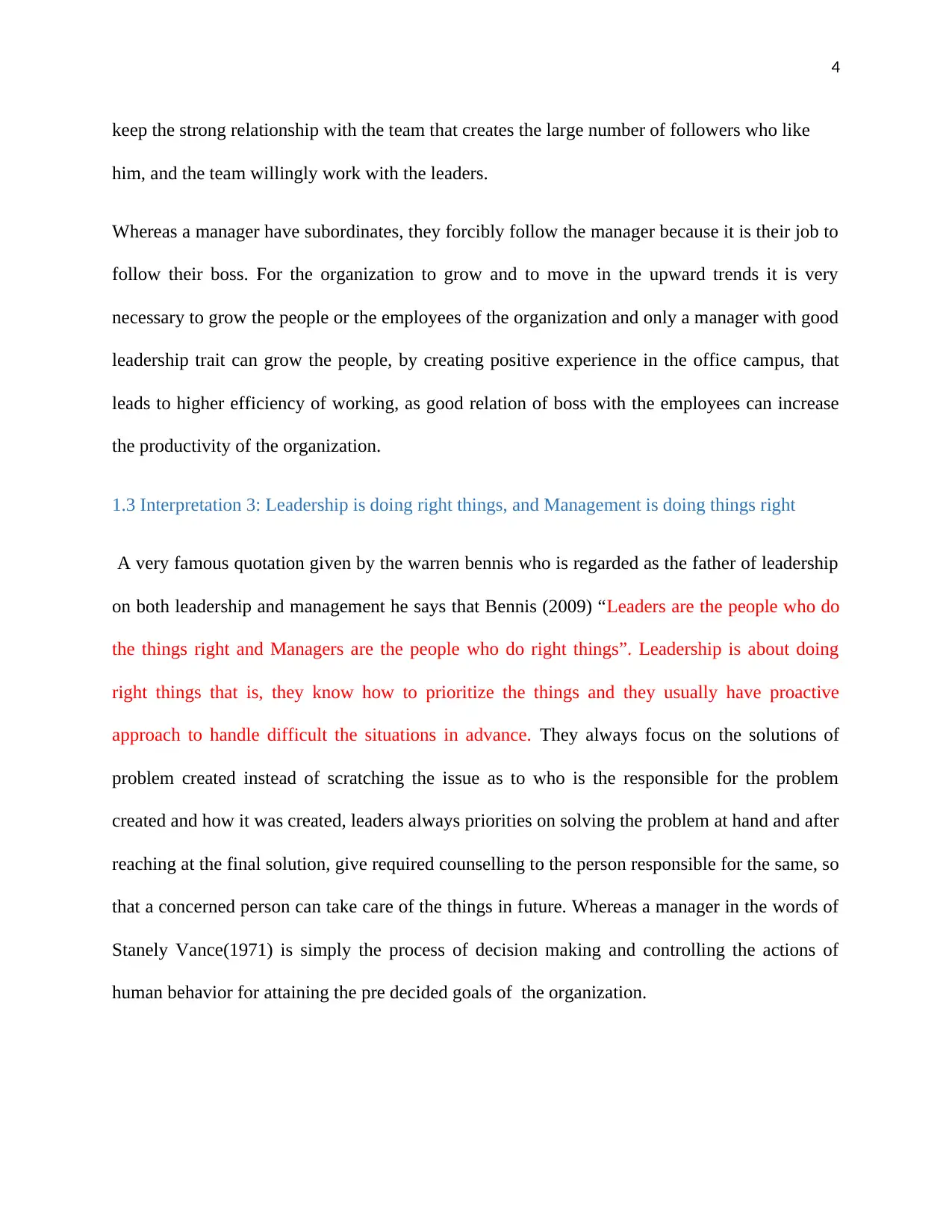
4
keep the strong relationship with the team that creates the large number of followers who like
him, and the team willingly work with the leaders.
Whereas a manager have subordinates, they forcibly follow the manager because it is their job to
follow their boss. For the organization to grow and to move in the upward trends it is very
necessary to grow the people or the employees of the organization and only a manager with good
leadership trait can grow the people, by creating positive experience in the office campus, that
leads to higher efficiency of working, as good relation of boss with the employees can increase
the productivity of the organization.
1.3 Interpretation 3: Leadership is doing right things, and Management is doing things right
A very famous quotation given by the warren bennis who is regarded as the father of leadership
on both leadership and management he says that Bennis (2009) “Leaders are the people who do
the things right and Managers are the people who do right things”. Leadership is about doing
right things that is, they know how to prioritize the things and they usually have proactive
approach to handle difficult the situations in advance. They always focus on the solutions of
problem created instead of scratching the issue as to who is the responsible for the problem
created and how it was created, leaders always priorities on solving the problem at hand and after
reaching at the final solution, give required counselling to the person responsible for the same, so
that a concerned person can take care of the things in future. Whereas a manager in the words of
Stanely Vance(1971) is simply the process of decision making and controlling the actions of
human behavior for attaining the pre decided goals of the organization.
keep the strong relationship with the team that creates the large number of followers who like
him, and the team willingly work with the leaders.
Whereas a manager have subordinates, they forcibly follow the manager because it is their job to
follow their boss. For the organization to grow and to move in the upward trends it is very
necessary to grow the people or the employees of the organization and only a manager with good
leadership trait can grow the people, by creating positive experience in the office campus, that
leads to higher efficiency of working, as good relation of boss with the employees can increase
the productivity of the organization.
1.3 Interpretation 3: Leadership is doing right things, and Management is doing things right
A very famous quotation given by the warren bennis who is regarded as the father of leadership
on both leadership and management he says that Bennis (2009) “Leaders are the people who do
the things right and Managers are the people who do right things”. Leadership is about doing
right things that is, they know how to prioritize the things and they usually have proactive
approach to handle difficult the situations in advance. They always focus on the solutions of
problem created instead of scratching the issue as to who is the responsible for the problem
created and how it was created, leaders always priorities on solving the problem at hand and after
reaching at the final solution, give required counselling to the person responsible for the same, so
that a concerned person can take care of the things in future. Whereas a manager in the words of
Stanely Vance(1971) is simply the process of decision making and controlling the actions of
human behavior for attaining the pre decided goals of the organization.
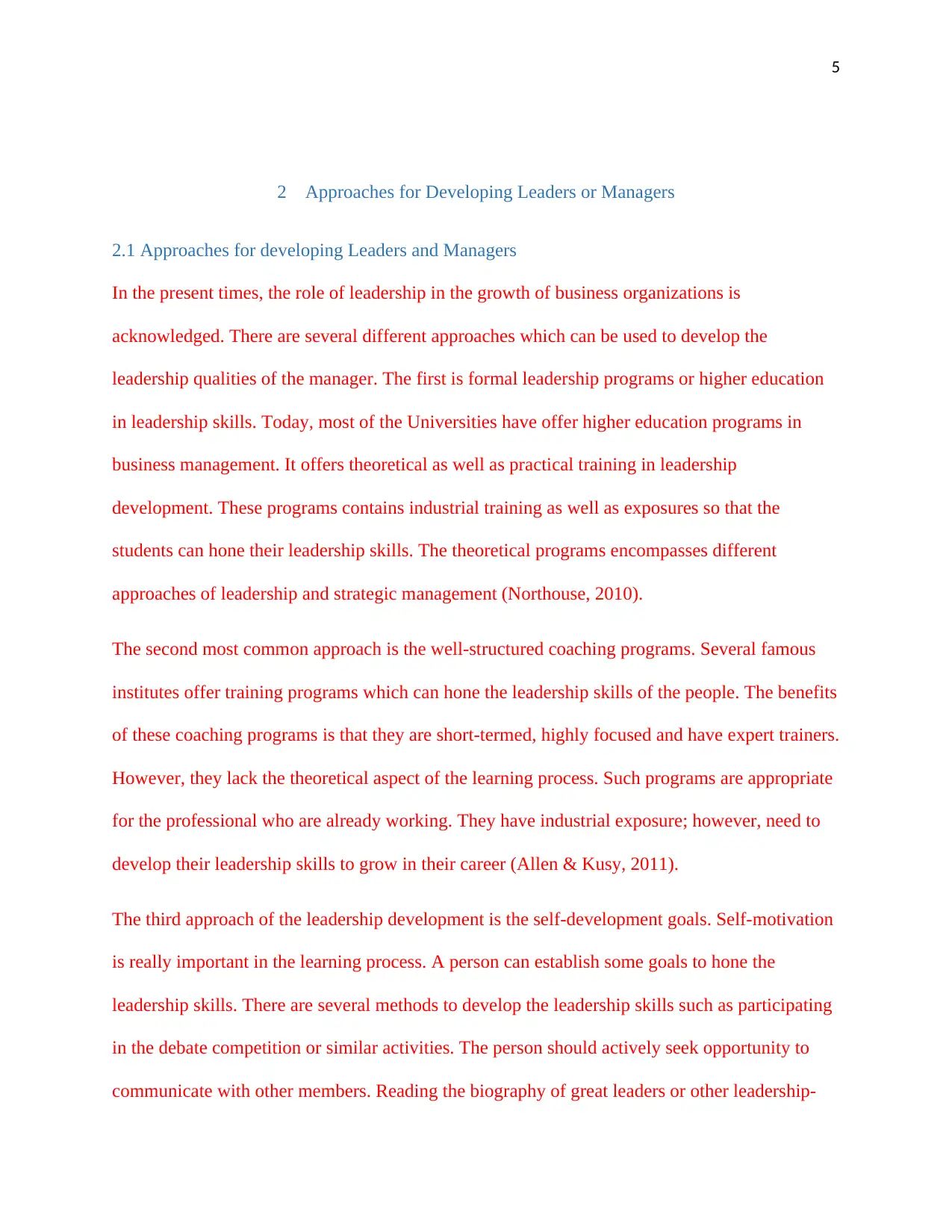
5
2 Approaches for Developing Leaders or Managers
2.1 Approaches for developing Leaders and Managers
In the present times, the role of leadership in the growth of business organizations is
acknowledged. There are several different approaches which can be used to develop the
leadership qualities of the manager. The first is formal leadership programs or higher education
in leadership skills. Today, most of the Universities have offer higher education programs in
business management. It offers theoretical as well as practical training in leadership
development. These programs contains industrial training as well as exposures so that the
students can hone their leadership skills. The theoretical programs encompasses different
approaches of leadership and strategic management (Northouse, 2010).
The second most common approach is the well-structured coaching programs. Several famous
institutes offer training programs which can hone the leadership skills of the people. The benefits
of these coaching programs is that they are short-termed, highly focused and have expert trainers.
However, they lack the theoretical aspect of the learning process. Such programs are appropriate
for the professional who are already working. They have industrial exposure; however, need to
develop their leadership skills to grow in their career (Allen & Kusy, 2011).
The third approach of the leadership development is the self-development goals. Self-motivation
is really important in the learning process. A person can establish some goals to hone the
leadership skills. There are several methods to develop the leadership skills such as participating
in the debate competition or similar activities. The person should actively seek opportunity to
communicate with other members. Reading the biography of great leaders or other leadership-
2 Approaches for Developing Leaders or Managers
2.1 Approaches for developing Leaders and Managers
In the present times, the role of leadership in the growth of business organizations is
acknowledged. There are several different approaches which can be used to develop the
leadership qualities of the manager. The first is formal leadership programs or higher education
in leadership skills. Today, most of the Universities have offer higher education programs in
business management. It offers theoretical as well as practical training in leadership
development. These programs contains industrial training as well as exposures so that the
students can hone their leadership skills. The theoretical programs encompasses different
approaches of leadership and strategic management (Northouse, 2010).
The second most common approach is the well-structured coaching programs. Several famous
institutes offer training programs which can hone the leadership skills of the people. The benefits
of these coaching programs is that they are short-termed, highly focused and have expert trainers.
However, they lack the theoretical aspect of the learning process. Such programs are appropriate
for the professional who are already working. They have industrial exposure; however, need to
develop their leadership skills to grow in their career (Allen & Kusy, 2011).
The third approach of the leadership development is the self-development goals. Self-motivation
is really important in the learning process. A person can establish some goals to hone the
leadership skills. There are several methods to develop the leadership skills such as participating
in the debate competition or similar activities. The person should actively seek opportunity to
communicate with other members. Reading the biography of great leaders or other leadership-
⊘ This is a preview!⊘
Do you want full access?
Subscribe today to unlock all pages.

Trusted by 1+ million students worldwide
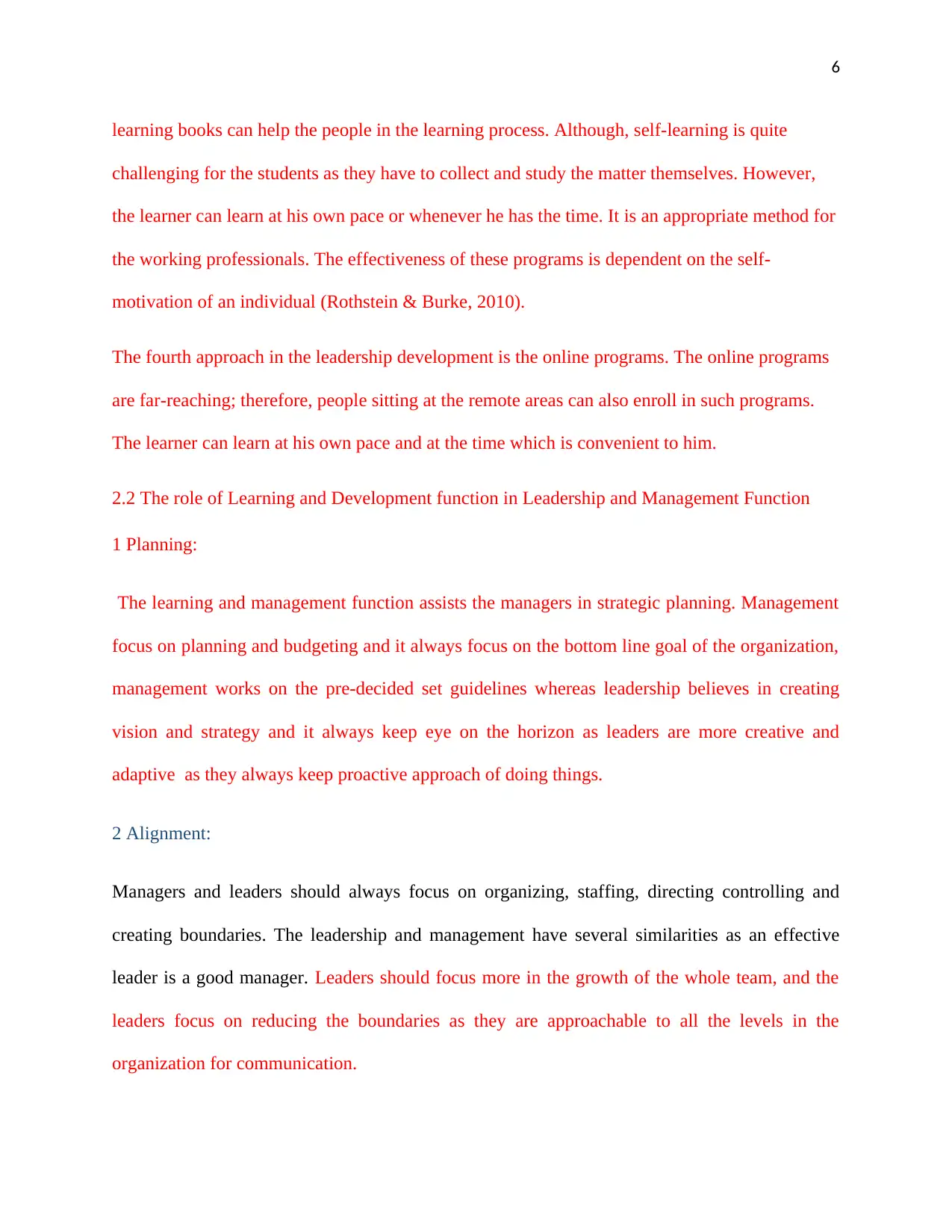
6
learning books can help the people in the learning process. Although, self-learning is quite
challenging for the students as they have to collect and study the matter themselves. However,
the learner can learn at his own pace or whenever he has the time. It is an appropriate method for
the working professionals. The effectiveness of these programs is dependent on the self-
motivation of an individual (Rothstein & Burke, 2010).
The fourth approach in the leadership development is the online programs. The online programs
are far-reaching; therefore, people sitting at the remote areas can also enroll in such programs.
The learner can learn at his own pace and at the time which is convenient to him.
2.2 The role of Learning and Development function in Leadership and Management Function
1 Planning:
The learning and management function assists the managers in strategic planning. Management
focus on planning and budgeting and it always focus on the bottom line goal of the organization,
management works on the pre-decided set guidelines whereas leadership believes in creating
vision and strategy and it always keep eye on the horizon as leaders are more creative and
adaptive as they always keep proactive approach of doing things.
2 Alignment:
Managers and leaders should always focus on organizing, staffing, directing controlling and
creating boundaries. The leadership and management have several similarities as an effective
leader is a good manager. Leaders should focus more in the growth of the whole team, and the
leaders focus on reducing the boundaries as they are approachable to all the levels in the
organization for communication.
learning books can help the people in the learning process. Although, self-learning is quite
challenging for the students as they have to collect and study the matter themselves. However,
the learner can learn at his own pace or whenever he has the time. It is an appropriate method for
the working professionals. The effectiveness of these programs is dependent on the self-
motivation of an individual (Rothstein & Burke, 2010).
The fourth approach in the leadership development is the online programs. The online programs
are far-reaching; therefore, people sitting at the remote areas can also enroll in such programs.
The learner can learn at his own pace and at the time which is convenient to him.
2.2 The role of Learning and Development function in Leadership and Management Function
1 Planning:
The learning and management function assists the managers in strategic planning. Management
focus on planning and budgeting and it always focus on the bottom line goal of the organization,
management works on the pre-decided set guidelines whereas leadership believes in creating
vision and strategy and it always keep eye on the horizon as leaders are more creative and
adaptive as they always keep proactive approach of doing things.
2 Alignment:
Managers and leaders should always focus on organizing, staffing, directing controlling and
creating boundaries. The leadership and management have several similarities as an effective
leader is a good manager. Leaders should focus more in the growth of the whole team, and the
leaders focus on reducing the boundaries as they are approachable to all the levels in the
organization for communication.
Paraphrase This Document
Need a fresh take? Get an instant paraphrase of this document with our AI Paraphraser
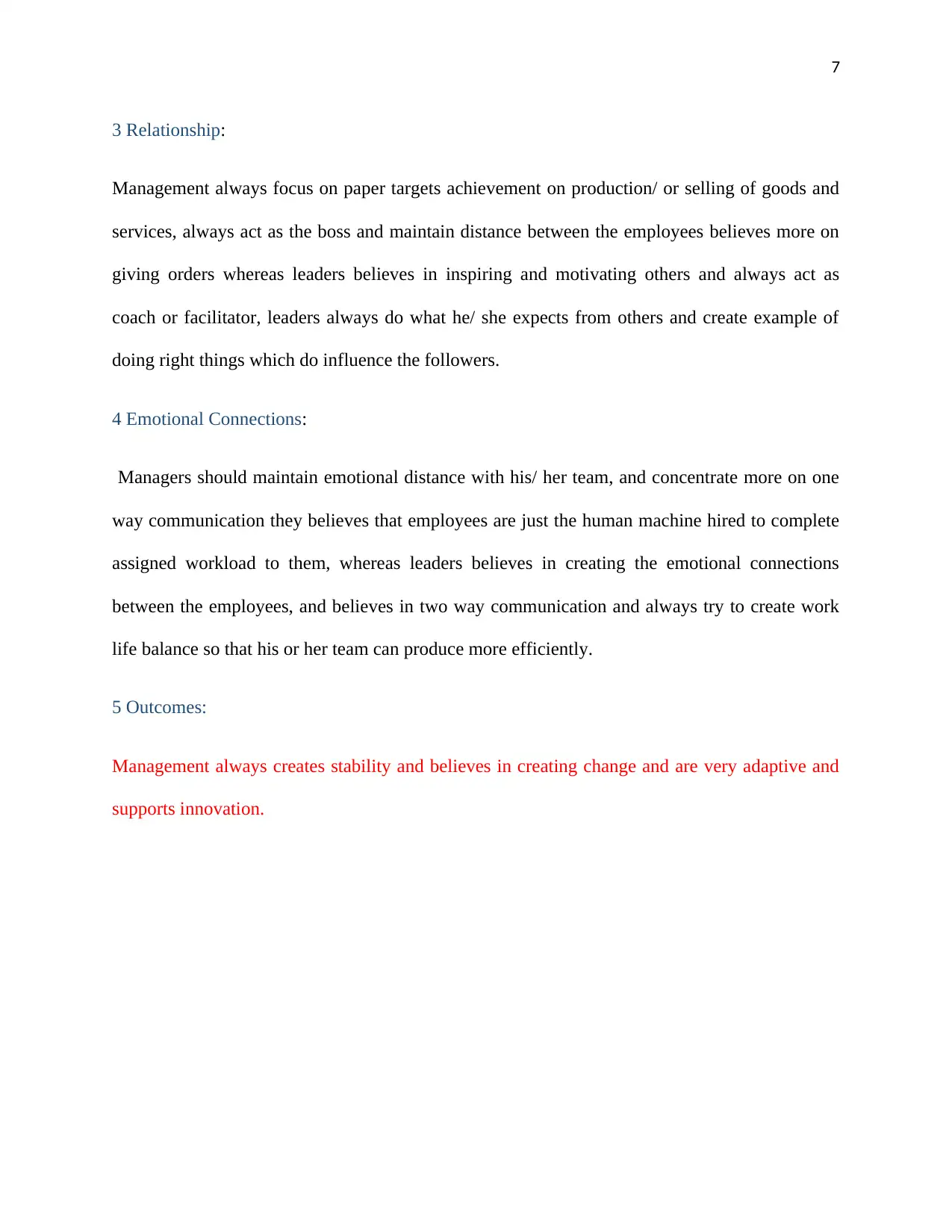
7
3 Relationship:
Management always focus on paper targets achievement on production/ or selling of goods and
services, always act as the boss and maintain distance between the employees believes more on
giving orders whereas leaders believes in inspiring and motivating others and always act as
coach or facilitator, leaders always do what he/ she expects from others and create example of
doing right things which do influence the followers.
4 Emotional Connections:
Managers should maintain emotional distance with his/ her team, and concentrate more on one
way communication they believes that employees are just the human machine hired to complete
assigned workload to them, whereas leaders believes in creating the emotional connections
between the employees, and believes in two way communication and always try to create work
life balance so that his or her team can produce more efficiently.
5 Outcomes:
Management always creates stability and believes in creating change and are very adaptive and
supports innovation.
3 Relationship:
Management always focus on paper targets achievement on production/ or selling of goods and
services, always act as the boss and maintain distance between the employees believes more on
giving orders whereas leaders believes in inspiring and motivating others and always act as
coach or facilitator, leaders always do what he/ she expects from others and create example of
doing right things which do influence the followers.
4 Emotional Connections:
Managers should maintain emotional distance with his/ her team, and concentrate more on one
way communication they believes that employees are just the human machine hired to complete
assigned workload to them, whereas leaders believes in creating the emotional connections
between the employees, and believes in two way communication and always try to create work
life balance so that his or her team can produce more efficiently.
5 Outcomes:
Management always creates stability and believes in creating change and are very adaptive and
supports innovation.
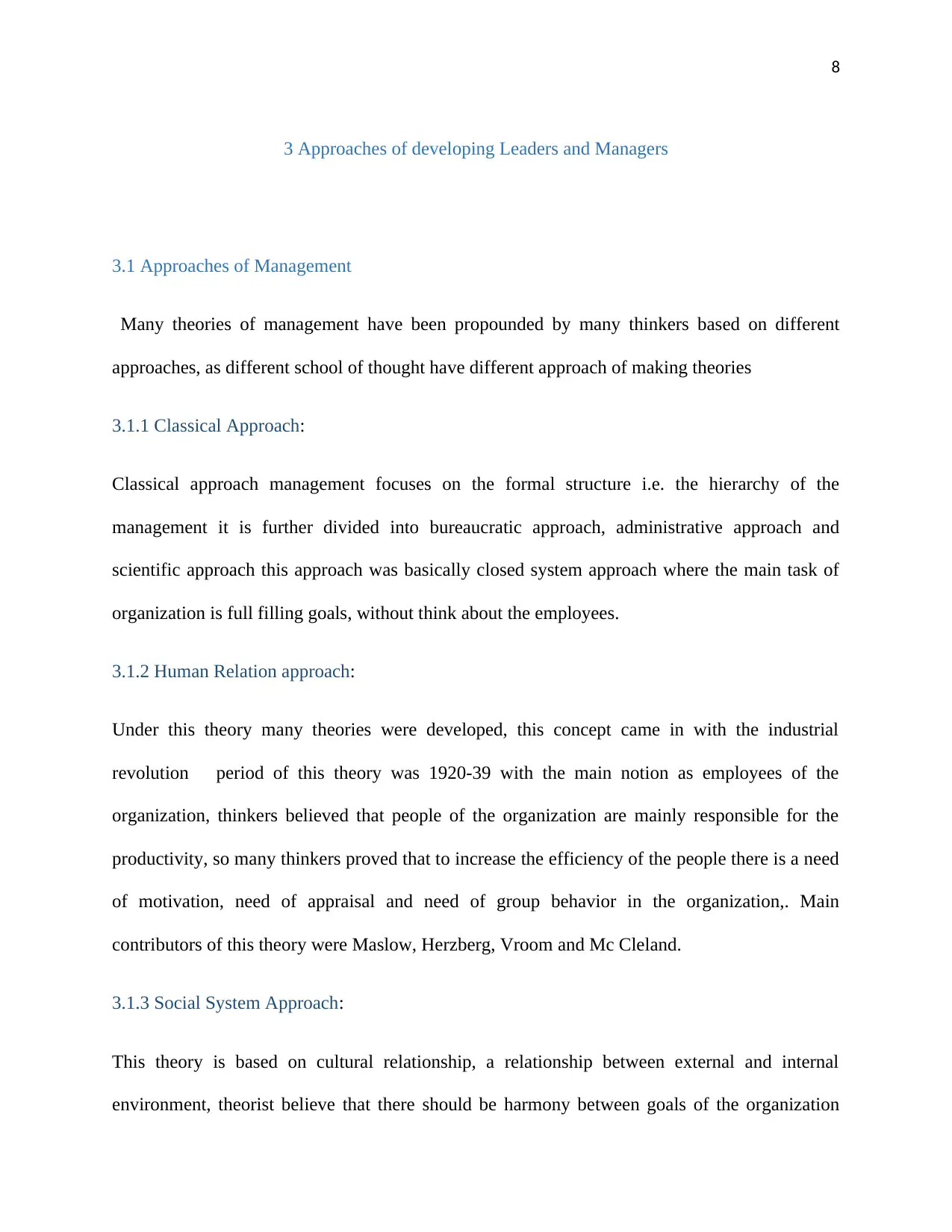
8
3 Approaches of developing Leaders and Managers
3.1 Approaches of Management
Many theories of management have been propounded by many thinkers based on different
approaches, as different school of thought have different approach of making theories
3.1.1 Classical Approach:
Classical approach management focuses on the formal structure i.e. the hierarchy of the
management it is further divided into bureaucratic approach, administrative approach and
scientific approach this approach was basically closed system approach where the main task of
organization is full filling goals, without think about the employees.
3.1.2 Human Relation approach:
Under this theory many theories were developed, this concept came in with the industrial
revolution period of this theory was 1920-39 with the main notion as employees of the
organization, thinkers believed that people of the organization are mainly responsible for the
productivity, so many thinkers proved that to increase the efficiency of the people there is a need
of motivation, need of appraisal and need of group behavior in the organization,. Main
contributors of this theory were Maslow, Herzberg, Vroom and Mc Cleland.
3.1.3 Social System Approach:
This theory is based on cultural relationship, a relationship between external and internal
environment, theorist believe that there should be harmony between goals of the organization
3 Approaches of developing Leaders and Managers
3.1 Approaches of Management
Many theories of management have been propounded by many thinkers based on different
approaches, as different school of thought have different approach of making theories
3.1.1 Classical Approach:
Classical approach management focuses on the formal structure i.e. the hierarchy of the
management it is further divided into bureaucratic approach, administrative approach and
scientific approach this approach was basically closed system approach where the main task of
organization is full filling goals, without think about the employees.
3.1.2 Human Relation approach:
Under this theory many theories were developed, this concept came in with the industrial
revolution period of this theory was 1920-39 with the main notion as employees of the
organization, thinkers believed that people of the organization are mainly responsible for the
productivity, so many thinkers proved that to increase the efficiency of the people there is a need
of motivation, need of appraisal and need of group behavior in the organization,. Main
contributors of this theory were Maslow, Herzberg, Vroom and Mc Cleland.
3.1.3 Social System Approach:
This theory is based on cultural relationship, a relationship between external and internal
environment, theorist believe that there should be harmony between goals of the organization
⊘ This is a preview!⊘
Do you want full access?
Subscribe today to unlock all pages.

Trusted by 1+ million students worldwide
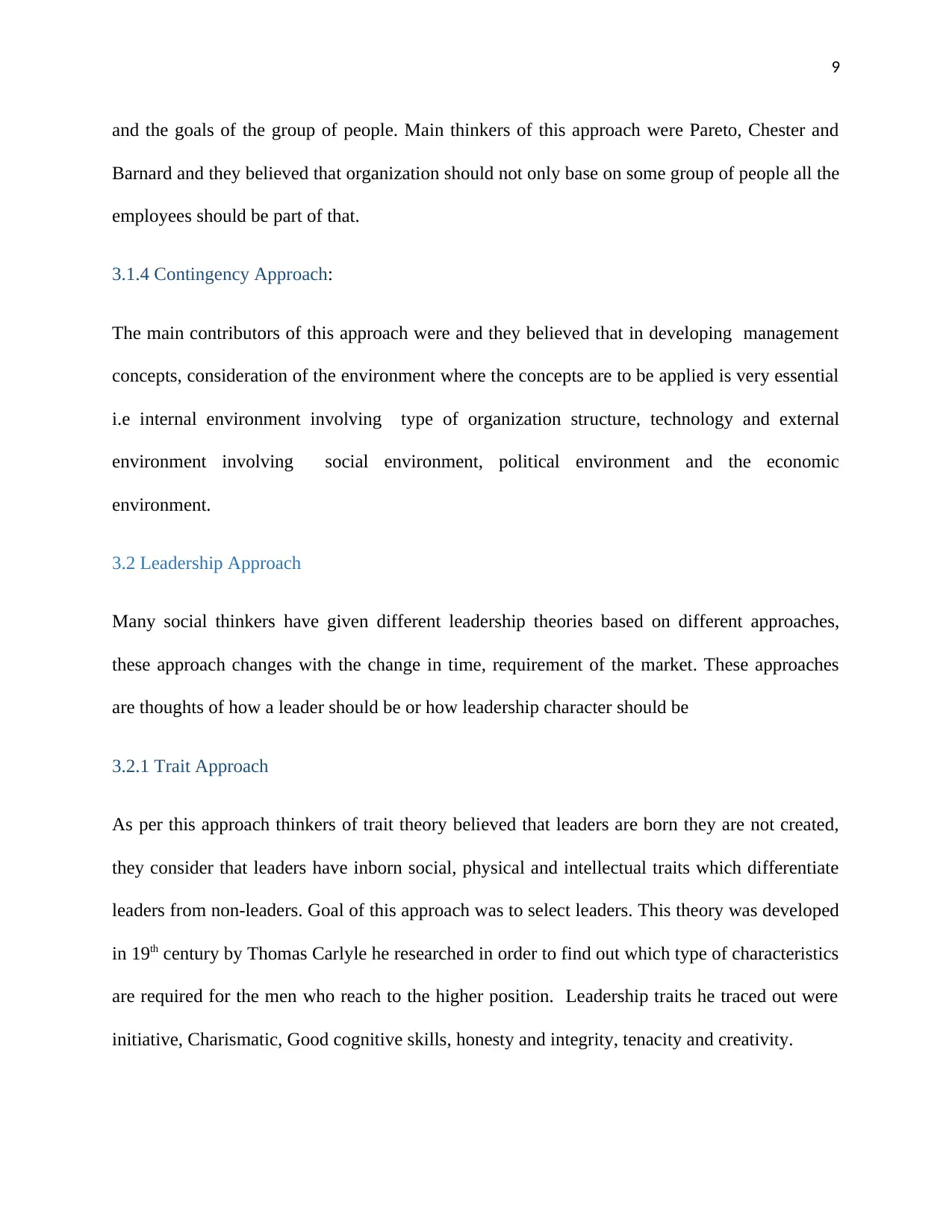
9
and the goals of the group of people. Main thinkers of this approach were Pareto, Chester and
Barnard and they believed that organization should not only base on some group of people all the
employees should be part of that.
3.1.4 Contingency Approach:
The main contributors of this approach were and they believed that in developing management
concepts, consideration of the environment where the concepts are to be applied is very essential
i.e internal environment involving type of organization structure, technology and external
environment involving social environment, political environment and the economic
environment.
3.2 Leadership Approach
Many social thinkers have given different leadership theories based on different approaches,
these approach changes with the change in time, requirement of the market. These approaches
are thoughts of how a leader should be or how leadership character should be
3.2.1 Trait Approach
As per this approach thinkers of trait theory believed that leaders are born they are not created,
they consider that leaders have inborn social, physical and intellectual traits which differentiate
leaders from non-leaders. Goal of this approach was to select leaders. This theory was developed
in 19th century by Thomas Carlyle he researched in order to find out which type of characteristics
are required for the men who reach to the higher position. Leadership traits he traced out were
initiative, Charismatic, Good cognitive skills, honesty and integrity, tenacity and creativity.
and the goals of the group of people. Main thinkers of this approach were Pareto, Chester and
Barnard and they believed that organization should not only base on some group of people all the
employees should be part of that.
3.1.4 Contingency Approach:
The main contributors of this approach were and they believed that in developing management
concepts, consideration of the environment where the concepts are to be applied is very essential
i.e internal environment involving type of organization structure, technology and external
environment involving social environment, political environment and the economic
environment.
3.2 Leadership Approach
Many social thinkers have given different leadership theories based on different approaches,
these approach changes with the change in time, requirement of the market. These approaches
are thoughts of how a leader should be or how leadership character should be
3.2.1 Trait Approach
As per this approach thinkers of trait theory believed that leaders are born they are not created,
they consider that leaders have inborn social, physical and intellectual traits which differentiate
leaders from non-leaders. Goal of this approach was to select leaders. This theory was developed
in 19th century by Thomas Carlyle he researched in order to find out which type of characteristics
are required for the men who reach to the higher position. Leadership traits he traced out were
initiative, Charismatic, Good cognitive skills, honesty and integrity, tenacity and creativity.
Paraphrase This Document
Need a fresh take? Get an instant paraphrase of this document with our AI Paraphraser
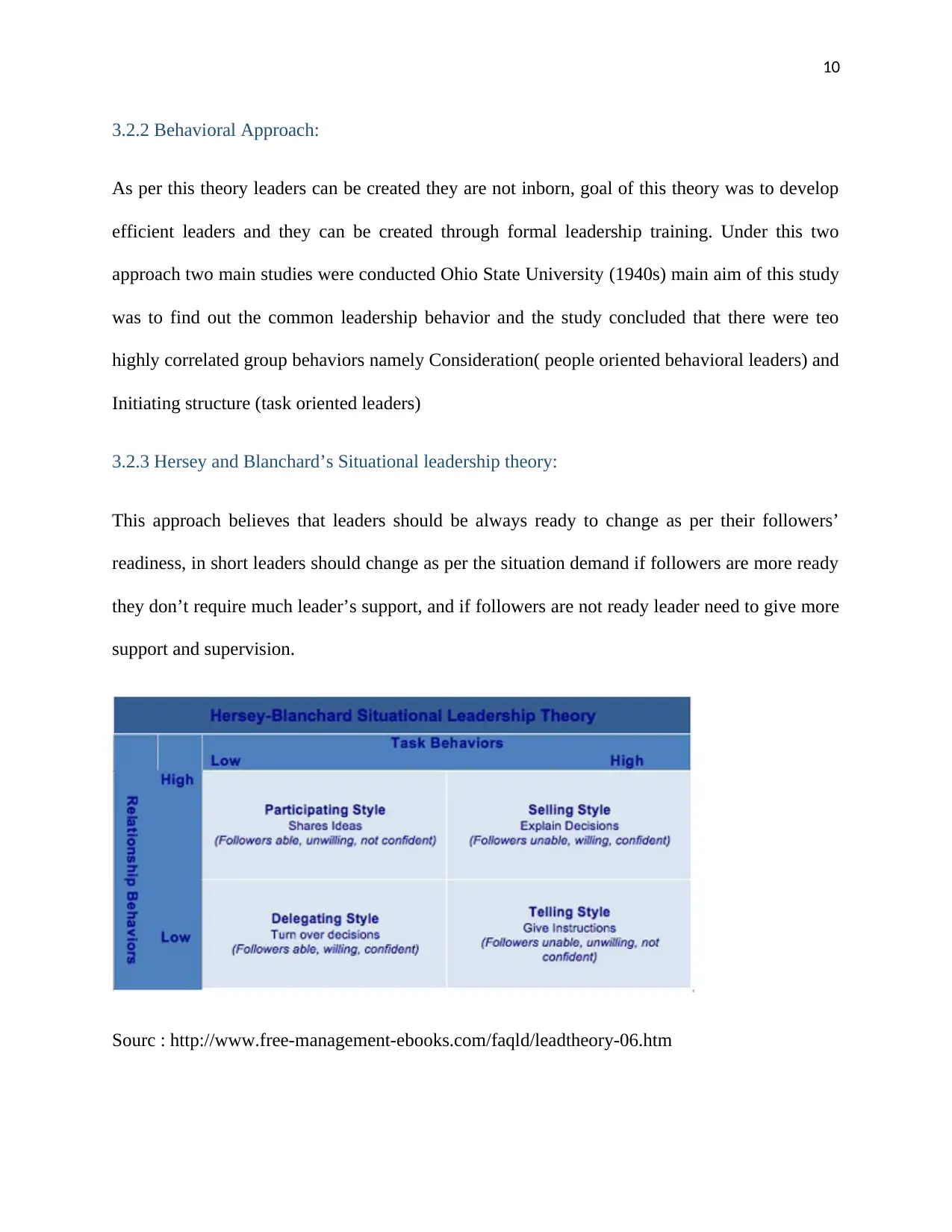
10
3.2.2 Behavioral Approach:
As per this theory leaders can be created they are not inborn, goal of this theory was to develop
efficient leaders and they can be created through formal leadership training. Under this two
approach two main studies were conducted Ohio State University (1940s) main aim of this study
was to find out the common leadership behavior and the study concluded that there were teo
highly correlated group behaviors namely Consideration( people oriented behavioral leaders) and
Initiating structure (task oriented leaders)
3.2.3 Hersey and Blanchard’s Situational leadership theory:
This approach believes that leaders should be always ready to change as per their followers’
readiness, in short leaders should change as per the situation demand if followers are more ready
they don’t require much leader’s support, and if followers are not ready leader need to give more
support and supervision.
Sourc : http://www.free-management-ebooks.com/faqld/leadtheory-06.htm
3.2.2 Behavioral Approach:
As per this theory leaders can be created they are not inborn, goal of this theory was to develop
efficient leaders and they can be created through formal leadership training. Under this two
approach two main studies were conducted Ohio State University (1940s) main aim of this study
was to find out the common leadership behavior and the study concluded that there were teo
highly correlated group behaviors namely Consideration( people oriented behavioral leaders) and
Initiating structure (task oriented leaders)
3.2.3 Hersey and Blanchard’s Situational leadership theory:
This approach believes that leaders should be always ready to change as per their followers’
readiness, in short leaders should change as per the situation demand if followers are more ready
they don’t require much leader’s support, and if followers are not ready leader need to give more
support and supervision.
Sourc : http://www.free-management-ebooks.com/faqld/leadtheory-06.htm
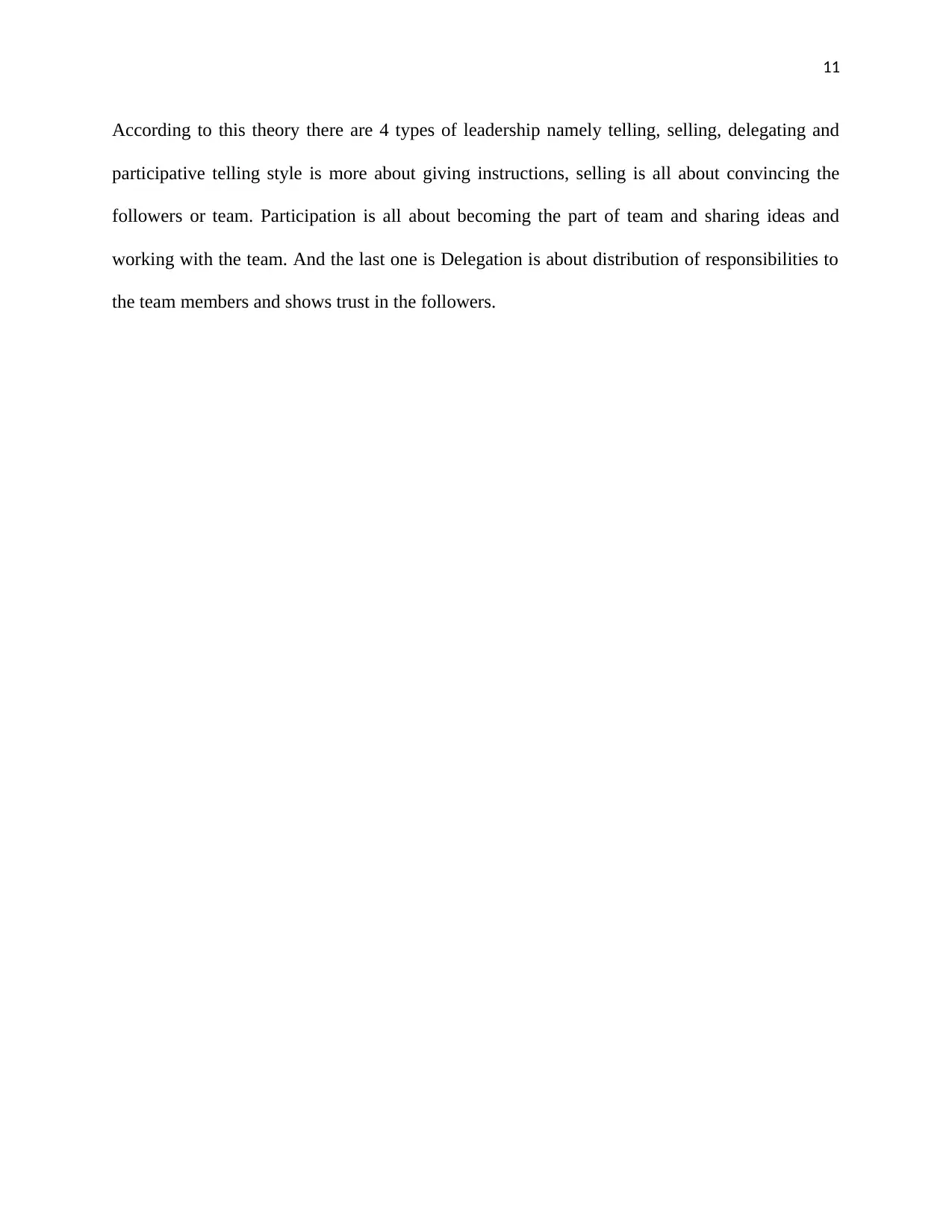
11
According to this theory there are 4 types of leadership namely telling, selling, delegating and
participative telling style is more about giving instructions, selling is all about convincing the
followers or team. Participation is all about becoming the part of team and sharing ideas and
working with the team. And the last one is Delegation is about distribution of responsibilities to
the team members and shows trust in the followers.
According to this theory there are 4 types of leadership namely telling, selling, delegating and
participative telling style is more about giving instructions, selling is all about convincing the
followers or team. Participation is all about becoming the part of team and sharing ideas and
working with the team. And the last one is Delegation is about distribution of responsibilities to
the team members and shows trust in the followers.
⊘ This is a preview!⊘
Do you want full access?
Subscribe today to unlock all pages.

Trusted by 1+ million students worldwide
1 out of 22
Related Documents
Your All-in-One AI-Powered Toolkit for Academic Success.
+13062052269
info@desklib.com
Available 24*7 on WhatsApp / Email
![[object Object]](/_next/static/media/star-bottom.7253800d.svg)
Unlock your academic potential
Copyright © 2020–2025 A2Z Services. All Rights Reserved. Developed and managed by ZUCOL.



